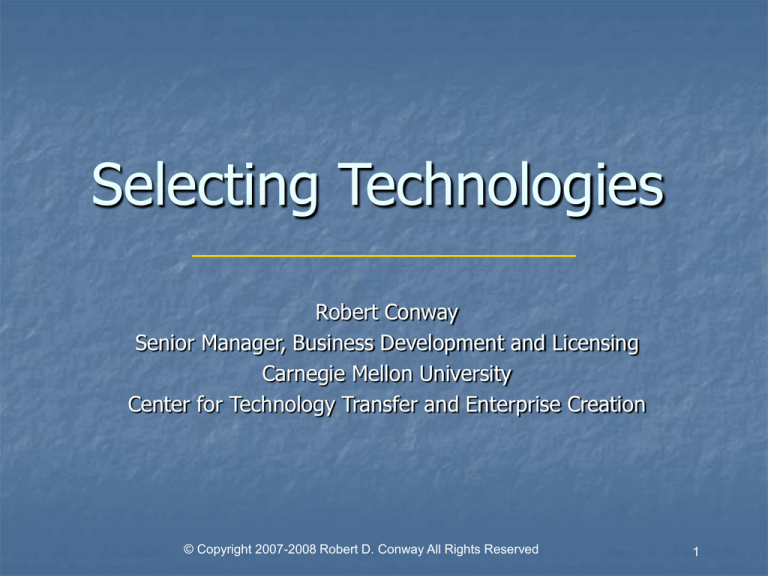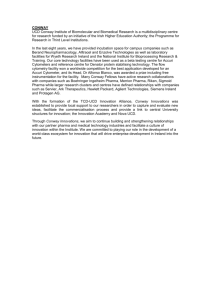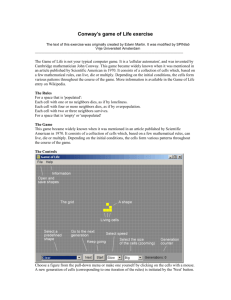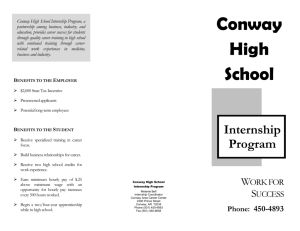
Selecting Technologies
Robert Conway
Senior Manager, Business Development and Licensing
Carnegie Mellon University
Center for Technology Transfer and Enterprise Creation
© Copyright 2007-2008 Robert D. Conway All Rights Reserved
1
References
Teece, David J., “Profiting from technological innovation:
Implications for integration, collaboration, licensing and
public policy”, UC Berkeley, School of Business
Administration, June 1986
Porter, Michael, Competitive Strategy: Techniques for
Analyzing Industries and Competitors, New York, Simon
& Schuster, 1998
Porter, Michael, Harvard Business School, various
published articles on “Porter’s Five Forces”, beginning in
1980, e.g. www.quickmba.com/strategy/generic.shtml
© Copyright 2007-2008 Robert D. Conway All Rights Reserved
2
Center for
Technology
Transfer
Inventors
Technology Transfer Process Overview
Researchers
create a
technology
Does CMU own
it? Who else has
rights?
Is there
commercial
potential?
Should we protect
it, e.g. patent,
copyright?
Market the
technology to
potential licensees
Industry
Roundtable
Negotiate
license
Licensee
Invention
Disclosure
form
Negotiate
license
Monitor licensee
performance
Licensee
creates
product
Product
sales
generate
revenue
Half of net
proceeds
Public
Dedication
Commercialization,
patent costs
License
revenue to
CMU
Half of net
proceeds
© Copyright 2007-2008 Robert D. Conway All Rights Reserved
3
Market Characteristics
What is the market – who will pay, and
how much? How will the resulting
product/service be positioned?
Market size
Market growth rate
Industry sector: concentrated or
fragmented?
Competitors
Complimentary assets
© Copyright 2007-2008 Robert D. Conway All Rights Reserved
4
Technology Characteristics
What problem does it solve? What pain
does it remove or risk does it reduce?
Revolutionary leap or evolutionary
improvement?
Product differentiation - benefits
Substitutions or comparables
Regulatory environment
Network effects
Protected technology?
© Copyright 2007-2008 Robert D. Conway All Rights Reserved
5
Industry Stage
Preparadigmatic phase:
many designs, no industry standard yet
complementary assets not yet a critical factor
Paradigmatic phase:
industry standard has emerged
complementary assets critical to success of
technology
© Copyright 2007-2008 Robert D. Conway All Rights Reserved
6
Complimentary Assets
Complementary assets may prove a hindrance to selling,
marketing, distributing, or supporting products based on this
technology.
Complementary assets are generalized and easily
accessible (no hindrance)
Complementary assets are specialized and are available (at
some cost, which needs to be considered)
Complementary assets are specialized to the product and
not available
One or more critical complementary assets are owned by
one or two firms
Complementary assets necessary for commercialization are
not available and may require considerable investment to
develop
List companies that maintain critical complementary assets
© Copyright 2007-2008 Robert D. Conway All Rights Reserved
7
Appropriability Regime
Tight or weak appropriability
Tight - technology can be protected through patents,
copyrights or trade secrets (tacit knowledge)
Weak – cannot protect, easily learned or discovered
process or knowledge
Technology is easy to protect: includes both
easy to defend patent and tacit knowledge
Technology is fairly easy to protect with some
tacit knowledge
Technology is not easy to protect and knowledge
is easily transferable or copied
Technology is difficult to protect.
© Copyright 2007-2008 Robert D. Conway All Rights Reserved
8
Time to Market Investment
Long Period
Short Period
Minor OK if timing is
Invest not critical
ment
Full Steam
Ahead
Major Forget It
Invest
ment
OK if cost
position
tolerable
Source: Teece, David J., “Profiting from technological innovation: Implications for integration, collaboration,
licensing and public policy”, UC Berkeley, School of Business Administration, June 1986
© Copyright 2007-2008 Robert D. Conway All Rights Reserved
9
The Acid Test
1. What is the value of the invention over existing methods? 2X,
10X, or 100X better than existing products? [<10X do not
pursue]
2. What is the economic or other benefit benefits over present
products? (cost, quality, benefits = competitive advantage)
3. Can other solutions achieve the same result?
4. Is there sufficient potential demand to provide an ample ROI?
5. How much product development is required? (Invention
maturity - time required for product development, marketing
and sales)
6. Can it generate significant revenue in the first five years?
7. Are there other applications for this invention? (Identify
specific companies in each industry that might want a license)
8. Do you have personal contacts at companies that may be
interested? Who will you call first, next, etc.?
© Copyright 2007-2008 Robert D. Conway All Rights Reserved
10
Could this be a startup company?
© Copyright 2007-2008 Robert D. Conway All Rights Reserved
11
Startup Assessment Tool (StAT)
Inventor Focus – startup interest, startup
experience, protected knowledge, industry
relationships
Market Focus – emerging market, platform
technology, network effects
Competitive Focus – market size,
complimentary assets, regulatory barriers,
substitution
Other – subjective factors (appropriability
regime, industry stage, etc.)
© Copyright 2007-2008 Robert D. Conway All Rights Reserved
12
Industry Roundtable Evaluation
Four to seven industry experts plus the
inventors
One hour
Related industries
Serial entrepreneurs
Experienced business people – government
regulations, union rules, tax implications, sales,
marketing, insurance, etc. (IT, HR, accounting)
5 min – introductions
10 min – inventor presentation
45 min – moderated discussion
No NDAs – no enabling or proprietary
information
© Copyright 2007-2008 Robert D. Conway All Rights Reserved
13
Porter’s Forces and Generic
Strategies
© Copyright 2007-2008 Robert D. Conway All Rights Reserved
14
Porter’s Five Forces
Industries have different profitability – some of
this difference is determined by industry
structure
Professor Michael Porter - Harvard Business
School – described five forces that drive
competition within an industry (1980)
The intensity of rivalry among existing competitors
The threat of entry by new competitors
Pressure from substitute products
The bargaining power of buyers
The bargaining power of suppliers
© Copyright 2007-2008 Robert D. Conway All Rights Reserved
15
Diagram of Porter’s
Five Forces
SUPPLIER POWER
- Supplier concentration
- Importance of volume to
supplier
- Differentiation of inputs
- Impact of inputs on cost or
differentiation
- Switching costs of firms in the
industry
- Presence of substitute inputs
- Threat of forward integration
- Cost relative to total purchases
in industry
BARRIERS TO ENTRY
- Absolute cost advantages
- Proprietary learning curve
- Access to inputs
- Government policy
- Economies of scale
- Capital requirements
- Brand identity
- Switching costs
- Access to distribution
- Expected retaliation
- Proprietary products
THREAT OFSUBSTITUTES
-Switching costs
-Buyer inclination to
substitute
-Price-performance
trade-off of substitutes
BUYER POWER
- Bargaining leverage
- Buyer volume
- Buyer information
- Brand identity
- Price sensitivity
- Threat of backward integration
- Product differentiation
- Buyer concentration vs.
industry
- Substitutes available
- Buyers' incentives
DEGREE OF RIVALRY
- Exit barriers
- Industry concentration
- Fixed costs/Value added
- Industry growth
- Intermittent overcapacity
- Product differences
- Switching costs
- Brand identity
- Diversity of rivals
- Corporate stakes
Porter’s Generic Strategies
Three generic business strategies regardless of
industry
Strategies depend on market size
(broad/narrow)
Industry leaders pursue a single strategy
Often the strategies are incompatible
Combining strategies can lead to stagnation
Corporations create separate businesses to follow
different strategies
Strategic focus does not guarantee success –
companies are still vulnerable to those that can
undermine their position
© Copyright 2007-2008 Robert D. Conway All Rights Reserved
17
Generic Strategies
Advantage
Target Scope
Low Cost
Product Uniqueness
Broad
(Industry Wide)
Cost Leadership
Strategy
Differentiation
Strategy
Narrow
(Market Segment)
Focus
Strategy
(low cost)
Focus
Strategy
(differentiation)
© Copyright 2007-2008 Robert D. Conway All Rights Reserved
18
Broad Industry Strategies
Low Cost
Product
Uniqueness
Cost
Leadership
Strategy
Differentiation
Strategy
Cost Leadership
Low cost provider
Larger market
share, lower profits
Differentiation
Superior features
Smaller market
share, higher
profits
© Copyright 2007-2008 Robert D. Conway All Rights Reserved
19
Focus Strategy
Narrow
(Market Segment)
Low Cost
Product
Uniqueness
Focus
Strategy
(low cost)
Focus
Strategy
(differentiation)
Cost or differentiation advantage in narrow segment
High customer loyalty deters rivals and new entrants
Lower volumes result in less supplier bargaining power
May pass higher costs to customers since substitute
products don’t exist
Vulnerable to imitators and changes in customer
preferences
Other focusers may be able to control sub-segments
© Copyright 2007-2008 Robert D. Conway All Rights Reserved
20
Forces and Strategies
Industry
Force
Generic Strategies
Cost Leadership
Differentiation
Entry Ability to cut price in Customer loyalty can
retaliation deters
discourage potential
Barriers potential entrants. entrants.
Buyer
Power
Supplier
Power
Focusing develops core
competencies that can act as an
entry barrier.
Ability to offer lower Large buyers have less
price to powerful
power to negotiate because
buyers.
of few close alternatives.
Large buyers have less power to
negotiate because of few
alternatives.
Better insulated
from powerful
suppliers.
Suppliers have power because of
low volumes, but a differentiationfocused firm is better able to pass
on supplier price increases.
use low price
Threat of Can
to defend against
Substitutes substitutes.
Rivalry
Focus
Better able to
compete on price.
Better able to pass on
supplier price increases to
customers.
Customer's become
Specialized products & core
attached to differentiating
competency protect against
attributes, reducing threat of
substitutes.
substitutes.
Brand loyalty to keep
customers from rivals.
Rivals cannot meet
differentiation-focused customer
needs.
© Copyright 2007-2008 Robert D. Conway All Rights Reserved
21
Selecting Technologies
Robert Conway
Senior Manager, Business Development and Licensing
Carnegie Mellon University
Center for Technology Transfer and Enterprise Creation
© Copyright 2007-2008 Robert D. Conway All Rights Reserved
22
Research
2005 AUTM Survey
$42.3 billion
Invention
17,382 disclosures
1 per $2.43 million
IP Protection
9,536 new patent applications
1 per $4.4 million
Commercialization
4,932 licenses and options
628 company starts
New Product Introductions
3641 new
527 new
products first
available in
2005
products
introduced from
1998 to 2005
Source: Association of University Technology Managers survey FY2005
© Copyright 2007-2008 Robert D. Conway All Rights Reserved
24
New Company Startups
628 new
company startups
in FY2005
5171 startup
companies
formed since
1980
Source: Association of University Technology Managers survey FY2005
© Copyright 2007-2008 Robert D. Conway All Rights Reserved
25
Stanford Experience over 30 years:
4,300 disclosures received
Approximately 30% were licensed
50% of the licenses produced less than
$10,000
Only 30 deals generated $1,000,000 or more
cumulatively
Of the 378 licenses generating any royalties,
only 39 generated $100,000 or more
Only one out of 4,300 was a blockbuster
Source: Katherine Ku, Director Stanford OTL
© Copyright 2007-2008 Robert D. Conway All Rights Reserved
26
Carnegie Mellon 1993-2005
Start-ups
74%
related to Carnegie Mellon: 171
within the Pittsburgh region
Average
per year: 12 (peak of 29 in 2000;
8 in FY06 to date)
Licenses
to small, local companies: 68
Technologies
all sizes: 114
licensed to local companies of
© Copyright 2007-2008 Robert D. Conway All Rights Reserved
27
CMU Inventions by School (%)
Heinz, 1
CFA, 2
H&SS, 1
Provost, 5
Other, 8
CIT, 40
MCS, 11
SCS, 33
Source: CTT 2005 Annual Report
© Copyright 2007-2008 Robert D. Conway All Rights Reserved
28
CMU Technology Transfer Statistics
FY05
FY04
FY03
FY02
Innovators Served
321
302
312
297
-
-
308
Invention Disclosures
132
95
97
102
114
106
108
Patents Filed
75
61
85
69
41
39
62
Patents Issued
33
35
81
33
27
27
39
License Agreements
23
21
26
18
16
16
20
102
64
48
35
37
27
52
7
4
1
4
5
4
4
All Agreements
Startup Companies
FY01
© Copyright 2007-2008 Robert D. Conway All Rights Reserved
FY00 Average
29





